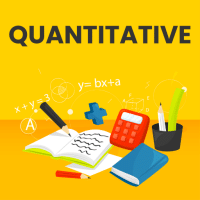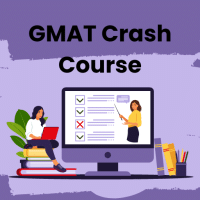GMAT Exam > GMAT Questions > For any integer P greater than 1, P! denotes ...
Start Learning for Free
For any integer P greater than 1, P! denotes the product of all the integers from 1 to P, inclusive. If one integer is selected at random between 5! And 5! + 10, inclusive, what is the probability that the chosen number will have only two factors?
- a)0
- b)1/11
- c)1/10
- d)2/11
- e)2/10
Correct answer is option 'B'. Can you explain this answer?
Verified Answer
For any integer P greater than 1, P! denotes the product of all the in...
Given:
- 1 integer is chosen from this list at random
To find: Probability that the chosen integer will have only 2 factors
Approach:
- A number that has only 2 factors is a Prime number. So, we need to find the probability of choosing a prime number between 120 and 130, inclusive
2. 
- So, to answer the question, we need to count the number of Prime Numbers in the list
Working Out:
- Finding the number of Prime numbers in the list
- The square root of all numbers in this list will be less than 12. So, we only need to consider the division of these candidates with prime numbers less than 12. These prime numbers are {2, 3, 5, 7, 11}
- Note, this is an application of the process to check if a number is prime. If you have any doubt about this, please revise the concept file.
- Checking for divisibility by 2: All the even numbers in the list are divisible by 2. So, they are definitely not prime. So, at this stage, only the odd numbers in the list have the possibility of being prime.
- The square root of all numbers in this list will be less than 12. So, we only need to consider the division of these candidates with prime numbers less than 12. These prime numbers are {2, 3, 5, 7, 11}
So, the candidates for primality at this stage are:
{121, 123, 125, 127, 129}
- Checking for divisibility by 3: In the above list, the numbers 123 (sum of digits = 1 + 2 + 3 = 6) and 129 (sum of digits = 1 + 2 + 9 = 12) are divisible by 3. So, they’re ruled out for the possibility of being prime.
- Checking for divisibility by 5: The number 125 is divisible by 5. So, it too is ruled out for the possibility of being prime.
- Checking for divisibility by 7: Neither of the 2 remaining candidates, 121 and 127, is divisible by 7. So, both of them remain possible candidates for being prime numbers.
- Checking for divisibility by 11: However, 121 is divisible by 11. So, it is ruled out as a candidate for being prime number.
- The only number standing at the end of all our divisibility checks is 127. So, since this number has passed the test of Primality, we can be confident that 127 is a prime number.
- Thus, there is only one prime number in the given list
- Finding the Required Probability.
Most Upvoted Answer
For any integer P greater than 1, P! denotes the product of all the in...
Problem Analysis:
We are given that P! represents the product of all integers from 1 to P, inclusive. We need to find the probability that a randomly chosen number between 5! and 5! * 10 (inclusive) will have only two factors.
Factors of a Number:
Factors of a number are the integers that divide the number without leaving a remainder. For example, the factors of 12 are 1, 2, 3, 4, 6, and 12.
Prime Numbers:
A prime number is a number greater than 1 that has no positive divisors other than 1 and itself. For example, 2, 3, 5, 7 are prime numbers.
Numbers with Two Factors:
Numbers with only two factors are prime numbers. Prime numbers have exactly two factors - 1 and the number itself.
Solution:
To find the probability that a randomly chosen number between 5! and 5! * 10 will have only two factors, we need to find out how many prime numbers exist in this range.
Range of Numbers:
5! = 5 * 4 * 3 * 2 * 1 = 120
5! * 10 = 120 * 10 = 1200
Counting Prime Numbers:
We need to count the number of prime numbers between 120 and 1200 (inclusive).
We can start by checking if each number in this range is prime or not. However, that would be a time-consuming process.
Alternatively, we can use the Sieve of Eratosthenes method to find all prime numbers up to a certain limit.
Sieve of Eratosthenes:
The Sieve of Eratosthenes is an ancient algorithm used to find all prime numbers up to a given limit.
Steps:
1. Create a list of all integers from 2 to the given limit.
2. Start with the smallest prime number, 2.
3. Mark all multiples of 2 as composite numbers.
4. Move to the next unmarked number, which is 3.
5. Mark all multiples of 3 as composite numbers.
6. Repeat steps 4 and 5 until you reach the square root of the given limit.
7. The remaining unmarked numbers in the list are prime numbers.
Using this method, we can find all prime numbers between 2 and 1200.
Prime Numbers between 2 and 1200:
2, 3, 5, 7, 11, 13, 17, 19, 23, 29, 31, 37, 41, 43, 47, 53, 59, 61, 67, 71, 73, 79, 83, 89, 97, 101, 103, 107, 109, 113, 127, 131, 137, 139, 149, 151, 157, 163, 167, 173, 179, 181, 191, 193, 197, 199, 211, 223, 227, 229, 233, 239, 241, 251, 257,
We are given that P! represents the product of all integers from 1 to P, inclusive. We need to find the probability that a randomly chosen number between 5! and 5! * 10 (inclusive) will have only two factors.
Factors of a Number:
Factors of a number are the integers that divide the number without leaving a remainder. For example, the factors of 12 are 1, 2, 3, 4, 6, and 12.
Prime Numbers:
A prime number is a number greater than 1 that has no positive divisors other than 1 and itself. For example, 2, 3, 5, 7 are prime numbers.
Numbers with Two Factors:
Numbers with only two factors are prime numbers. Prime numbers have exactly two factors - 1 and the number itself.
Solution:
To find the probability that a randomly chosen number between 5! and 5! * 10 will have only two factors, we need to find out how many prime numbers exist in this range.
Range of Numbers:
5! = 5 * 4 * 3 * 2 * 1 = 120
5! * 10 = 120 * 10 = 1200
Counting Prime Numbers:
We need to count the number of prime numbers between 120 and 1200 (inclusive).
We can start by checking if each number in this range is prime or not. However, that would be a time-consuming process.
Alternatively, we can use the Sieve of Eratosthenes method to find all prime numbers up to a certain limit.
Sieve of Eratosthenes:
The Sieve of Eratosthenes is an ancient algorithm used to find all prime numbers up to a given limit.
Steps:
1. Create a list of all integers from 2 to the given limit.
2. Start with the smallest prime number, 2.
3. Mark all multiples of 2 as composite numbers.
4. Move to the next unmarked number, which is 3.
5. Mark all multiples of 3 as composite numbers.
6. Repeat steps 4 and 5 until you reach the square root of the given limit.
7. The remaining unmarked numbers in the list are prime numbers.
Using this method, we can find all prime numbers between 2 and 1200.
Prime Numbers between 2 and 1200:
2, 3, 5, 7, 11, 13, 17, 19, 23, 29, 31, 37, 41, 43, 47, 53, 59, 61, 67, 71, 73, 79, 83, 89, 97, 101, 103, 107, 109, 113, 127, 131, 137, 139, 149, 151, 157, 163, 167, 173, 179, 181, 191, 193, 197, 199, 211, 223, 227, 229, 233, 239, 241, 251, 257,

|
Explore Courses for GMAT exam
|

|
Similar GMAT Doubts
Question Description
For any integer P greater than 1, P! denotes the product of all the integers from 1 to P, inclusive. If one integer is selected at random between 5! And 5! + 10, inclusive, what is the probability that the chosen number will have only two factors?a)0b)1/11c)1/10d)2/11e)2/10Correct answer is option 'B'. Can you explain this answer? for GMAT 2025 is part of GMAT preparation. The Question and answers have been prepared according to the GMAT exam syllabus. Information about For any integer P greater than 1, P! denotes the product of all the integers from 1 to P, inclusive. If one integer is selected at random between 5! And 5! + 10, inclusive, what is the probability that the chosen number will have only two factors?a)0b)1/11c)1/10d)2/11e)2/10Correct answer is option 'B'. Can you explain this answer? covers all topics & solutions for GMAT 2025 Exam. Find important definitions, questions, meanings, examples, exercises and tests below for For any integer P greater than 1, P! denotes the product of all the integers from 1 to P, inclusive. If one integer is selected at random between 5! And 5! + 10, inclusive, what is the probability that the chosen number will have only two factors?a)0b)1/11c)1/10d)2/11e)2/10Correct answer is option 'B'. Can you explain this answer?.
For any integer P greater than 1, P! denotes the product of all the integers from 1 to P, inclusive. If one integer is selected at random between 5! And 5! + 10, inclusive, what is the probability that the chosen number will have only two factors?a)0b)1/11c)1/10d)2/11e)2/10Correct answer is option 'B'. Can you explain this answer? for GMAT 2025 is part of GMAT preparation. The Question and answers have been prepared according to the GMAT exam syllabus. Information about For any integer P greater than 1, P! denotes the product of all the integers from 1 to P, inclusive. If one integer is selected at random between 5! And 5! + 10, inclusive, what is the probability that the chosen number will have only two factors?a)0b)1/11c)1/10d)2/11e)2/10Correct answer is option 'B'. Can you explain this answer? covers all topics & solutions for GMAT 2025 Exam. Find important definitions, questions, meanings, examples, exercises and tests below for For any integer P greater than 1, P! denotes the product of all the integers from 1 to P, inclusive. If one integer is selected at random between 5! And 5! + 10, inclusive, what is the probability that the chosen number will have only two factors?a)0b)1/11c)1/10d)2/11e)2/10Correct answer is option 'B'. Can you explain this answer?.
Solutions for For any integer P greater than 1, P! denotes the product of all the integers from 1 to P, inclusive. If one integer is selected at random between 5! And 5! + 10, inclusive, what is the probability that the chosen number will have only two factors?a)0b)1/11c)1/10d)2/11e)2/10Correct answer is option 'B'. Can you explain this answer? in English & in Hindi are available as part of our courses for GMAT.
Download more important topics, notes, lectures and mock test series for GMAT Exam by signing up for free.
Here you can find the meaning of For any integer P greater than 1, P! denotes the product of all the integers from 1 to P, inclusive. If one integer is selected at random between 5! And 5! + 10, inclusive, what is the probability that the chosen number will have only two factors?a)0b)1/11c)1/10d)2/11e)2/10Correct answer is option 'B'. Can you explain this answer? defined & explained in the simplest way possible. Besides giving the explanation of
For any integer P greater than 1, P! denotes the product of all the integers from 1 to P, inclusive. If one integer is selected at random between 5! And 5! + 10, inclusive, what is the probability that the chosen number will have only two factors?a)0b)1/11c)1/10d)2/11e)2/10Correct answer is option 'B'. Can you explain this answer?, a detailed solution for For any integer P greater than 1, P! denotes the product of all the integers from 1 to P, inclusive. If one integer is selected at random between 5! And 5! + 10, inclusive, what is the probability that the chosen number will have only two factors?a)0b)1/11c)1/10d)2/11e)2/10Correct answer is option 'B'. Can you explain this answer? has been provided alongside types of For any integer P greater than 1, P! denotes the product of all the integers from 1 to P, inclusive. If one integer is selected at random between 5! And 5! + 10, inclusive, what is the probability that the chosen number will have only two factors?a)0b)1/11c)1/10d)2/11e)2/10Correct answer is option 'B'. Can you explain this answer? theory, EduRev gives you an
ample number of questions to practice For any integer P greater than 1, P! denotes the product of all the integers from 1 to P, inclusive. If one integer is selected at random between 5! And 5! + 10, inclusive, what is the probability that the chosen number will have only two factors?a)0b)1/11c)1/10d)2/11e)2/10Correct answer is option 'B'. Can you explain this answer? tests, examples and also practice GMAT tests.

|
Explore Courses for GMAT exam
|

|
Signup to solve all Doubts
Signup to see your scores go up within 7 days! Learn & Practice with 1000+ FREE Notes, Videos & Tests.




























